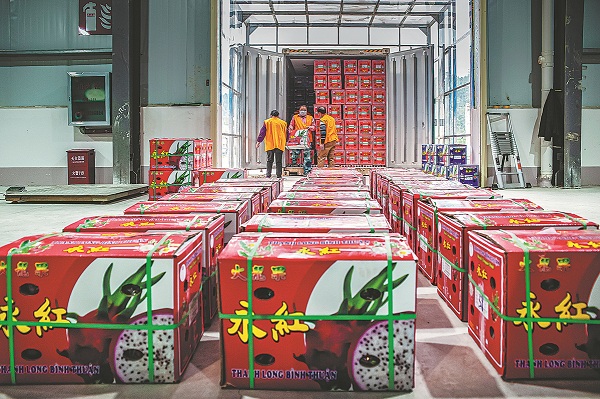Vietnamese dragon fruit imports roar to life

Imported dragon fruit awaits Customs inspection in Pingxiang, Guangxi. [Photo by ZHANG SHUHUI/FOR CHINA DAILY]
Dragon fruit is one of Vietnam's main fruit exports. About 300,000 metric tons of the fruit are expected to be available this season on the market in Vietnam, and a significant portion of that will be exported to China. It is expected to come through ports in the Guangxi Zhuang autonomous region, according to Guangxi TWT Supply Chain Management Co Ltd, a fruit trading company based in Nanning, Guangxi.
Last year, Vietnamese exports of dragon fruit reached $1.04 billion. Some $925.7 million of that was sent to China, accounting for about 89 percent of the total value, according to Guangxi TWT.
Since January, some border ports connecting Southeast Asian countries and China have been temporarily closed due to the COVID-19 pandemic and trucks held at the ports.
Given China's strict pandemic prevention and control pressures and simultaneous demand for imported fruit, traders started to seek other innovative options to solve the logistics problem. Starting in late February, in coordination with the local government of Guangxi, tractors were allowed to pull up and disconnect from their trailers at Puzhai Port, a trade zone in Guangxi bordering Vietnam.
The tractors would drive away from the Customs inspection site and be available for other transportation work. The trailer and goods would remain to await declaration procedures.
"The transportation model has helped improve the turnover efficiency of tractors, reduced logistics costs, and meant more economic benefit for traders," said Wang Zhengbo, president of TWT Supply Chain Management.
"We should ensure the smoothness of the cross-border supply chain and transportation for imported agricultural products, and make sure pandemic prevention and control measures are in line with the requirements of the ASEAN markets and the Chinese government," Wang said.
Over the past three decades, China-ASEAN economic ties have grown at a rapid pace, and 2021 marked the 30th anniversary of the establishment of the China-ASEAN dialogue partnership.
Despite the negative impact of the pandemic, trade between China and ASEAN nations still shows strong growth momentum. In 2021, cross-border trains connecting Nanning and Hanoi, Vietnam, operated 346 freight round trips, and the number surged 108.4 percent year-on-year, according to China Railway Nanning Group Co Ltd.
Vietnam is exporting nine kinds of fruit to China through cross-border trade-dragon fruit, watermelons, litchi, bananas, mangos, jackfruit, rambutans, longans and mangosteens.
The Ministry of Industry and Trade of Vietnam recently urged Vietnamese enterprises to strictly abide by China's regulations on quality inspections, quarantine, product traceability and packaging of imported agricultural products, and strictly implement related pandemic prevention and control measures.
By the end of 2020, areas planted to dragon fruit in China reached 35,555 hectares, similar to the area dedicated to the fruit's cultivation in Vietnam. With the increasing popularity of dragon fruit in China, its area of cultivation in the nation is expected to have reached 40,000 hectares in 2021, according to the Ministry of Commerce.
In China, dragon fruit is grown mainly in Guangxi and Guangdong provinces, and the two regions account for about 60 percent of the total nationwide, according to industry reports.
In 2021, the total value of fruit imported by China reached $13.47 billion, jumping 30.9 percent year-on-year. The imports reached 7.03 million tons, up 11.5 percent year-on-year, according to the General Administration of Customs.
China's fruit exports have declined due to the pandemic. Last year, China exported 3.55 million tons of fruit, down 8.3 percent year-on-year. The value of fruit exports reached $5.43 billion, declining 14.9 percent over the previous year, according to Customs officials.
